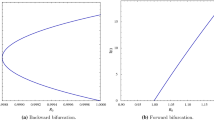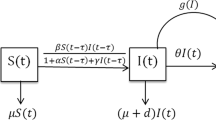Abstract
In the present study, a time-delayed SIR epidemic model with a logistic growth of susceptibles, Crowley–Martin type incidence, and Holling type III treatment rates is proposed and analyzed mathematically. We consider two explicit time-delays: one in the incidence rate of new infection to measuring the impact of the latent period, and another in the treatment rate of infectives to analyzing the effect of late treatment availability. The stability behavior of the model is analyzed for two equilibria: the disease-free equilibrium (DFE) and the endemic equilibrium (EE). We derive the threshold quantity, the basic reproduction number \(R_0\), which determines the eradication or persistence of infectious diseases in the host population. Using the basic reproduction number, we show that the DFE is locally asymptotically stable when \(R_0< 1\), linearly neutrally stable when \(R_0= 1\), and unstable when \(R_0> 1\) for the time-delayed system. We analyze the system without a latent period, revealing the forward bifurcation at \(R_0= 1\), which implies that keeping \(R_0\) below unity can diminish the disease. Further, the stability behavior for the EE is investigated, demonstrating the occurrence of oscillatory and periodic solutions through Hopf bifurcation concerning every possible grouping of two time-delays as the bifurcation parameter. To conclude, the numerical simulations in support of the theoretical findings are carried out.








Similar content being viewed by others
References
Owolabi, K.M.: Mathematical study of two-variable systems with adaptive numerical methods. Numer. Anal. Appl. 9, 218–230 (2016)
Owolabi, K.M.: Numerical solution of diffusive HBV model in a fractional medium. SpringerPlus 5, 1643 (2016)
Owolabi, K.M., Patidar, K.C.: Numerical simulations of multicomponent ecological models with adaptive methods. Theor. Biol. Med. Model. 13, 1 (2016)
Owolabi, K.M., Patidar, K.C., Shikongo, A.: Mathematical analysis and numerical simulation of a tumor-host model with chemotherapy application. Commun. Math. Biol. Neurosci. 2018, 21 (2018)
Owolabi, K.M., Patidar, K.C., Shikongo, A.: Efficient numerical method for a model arising in biological stoichiometry of tumour dynamics. Discrete Contin. Dyn. Syst.S 12(3), 591–613 (2019)
Owolabi, K.M., Atangana, A.: Mathematical analysis and computational experiments for an epidemic system with nonlocal and nonsingular derivative. Chaos Solitons Fract. 126, 41–49 (2019)
Owolabi, K.M., Shikongo, A.: Mathematical modelling of multi-mutation and drug resistance model with fractional derivative. Alex. Eng. J. 59(4), 2291–2304 (2020)
Mishra, A.M., Purohit, S.D., Owolabi, K.M., Sharma, Y.D.: A nonlinear epidemiological model considering asymptotic and quarantine classes for SARS CoV-2 virus. Chaos Solitons Fract. 138, 109953 (2020)
Kermack, W.O., Mckendrick, A.G.: A contribution to the mathematical theory of epidemic. Proc. R. Soc. Lond. 115(772), 700–721 (1927)
Hethcote, H.W., van den Driessche, P.: An SIS epidemic model with variable population size and a delay. J. Math. Biol. 34, 177–194 (1995)
d’Onofrio, A., Manfredi, P., Salinelli, E.: Vaccinating behaviour, information, and the dynamics of SIR vaccine preventable diseases. Theor. Popul. Biol. 71(3), 301–317 (2007)
Zhang, J.Z., Jin, Z., Liu, Q.X., Zhang, Z.Y.: Analysis of a delayed SIR model with nonlinear incidence rate. Discrete Dyn. Nat. Soc. 2008, 636153 (2009)
Wang, J.J., Zhang, J.Z., Jin, Z.: Analysis of an SIR model with bilinear incidence rate. Nonlinear Anal. Real World Appl. 11(4), 2390–2402 (2010)
Xue, Y., Li, T.: Stability and Hopf bifurcation for a delayed SIR epidemic model with logistic growth. Abstr. Appl. Anal. 2013, 916130 (2013)
Kumar, A., Nilam: Dynamic Behavior of an SIR epidemic model along with time delay; Crowley–Martin type incidence rate and Holling type II treatment rate. Int. J. Nonlinear Sci. Numer. Simul. 20(7–8), 757–771 (2019)
Goel, K., Nilam: Stability behavior of a nonlinear mathematical epidemic transmission model with time delay. Nonlinear Dyn. 98, 1501–1518 (2019)
Mena-Lorca, J., Hethcote, H.W.: Dynamic models of infectious disease as regulators of population size. J. Math. Biol. 30(7), 693–716 (1992)
Gumel, A.B., McCluskey, C.C., Watmough, J.: An SVEIR model for assessing potential impact of an imperfect anti-SARS vaccine. Math. Biosci. Eng. 3(3), 485–512 (2007)
Tipsri, S., Chinviriyasit, W.: Stability analysis of SEIR model with saturated incidence and time delay. Int. J. Appl. Phys. Math. 4(1), 42–45 (2014)
Goel, K., Kumar, A., Nilam: A deterministic time-delayed SVIRS epidemic model with incidences and saturated treatment. J. Eng. Math. 121, 19–38 (2020)
Goel, K., Kumar, A., Nilam: Nonlinear dynamics of a time-delayed epidemic model with two explicit aware classes, saturated incidences, and treatment. Nonlinear Dyn. 101, 1693–1715 (2020)
Kumar, A.: Stability of a fractional-order epidemic model with nonlinear incidences and treatment rates. Iran. J. Sci. Technol. Trans. A Sci. 44, 1505–1517 (2020)
Liu, W., Levin, S.A., Iwasa, Y.: Influence of nonlinear incidence rates upon the behavior of SIRS epidemiological models. J. Math. Biol. 23, 187–204 (1986)
Dubey, B., Patra, A., Srivastava, P.K., Dubey, U.S.: Modeling and analysis of an SEIR model with different types of nonlinear treatment rates. J. Biol. Syst. 21(03), 1350023 (2013)
Dubey, P., Dubey, B., Dubey, U.S.: An SIR model with nonlinear incidence rate and Holling type III treatment rate. In: Cushing, J., Saleem, M., Srivastava, H., Khan, M., Merajuddin, M. (eds.) Applied Analysis in Biological and Physical Sciences. Springer Proceedings in Mathematics and Statistics 186, Springer, New Delhi (2016)
Crowley, P.H., Martin, E.K.: Functional responses and interference within and between year classes of a dragonfly population. J. N. Am. Benthol. Soc. 8(3), 211–221 (1989)
Song, X., Cheng, S.: A delay-differential equation model of HIV infection of CD4+ T-cells. J. Korean Math. Soc. 42(5), 1071–1086 (2005)
Xu, R., Ma, Z.: Stability of a delayed SIRS epidemic model with a nonlinear incidence rate. Chaos Solitons Fract. 41(5), 2319–2325 (2009)
Shan, C., Zhu, H.: Bifurcations and complex dynamics of an SIR model with the impact of the number of hospital beds. J. Differ. Equ. 257(5), 1662–1688 (2014)
Wang, W., Ruan, S.: Bifurcation in an epidemic model with constant removal rates of the infectives. J. Math. Anal. Appl. 21, 775–793 (2004)
Wang, W.: Backward bifurcation of an epidemic model with treatment. Math. Biosci. 201, 58–71 (2006)
Zhou, L., Fan, M.: Dynamics of an SIR epidemic model with limited medical resources revisited. Nonlinear Anal. Real World Appl. 13(1), 312–324 (2012)
Wu, K., Darcet, D., Wang, Q., Sornette, D.: Generalized logistic growth modeling of the COVID-19 outbreak: comparing the dynamics in the 29 provinces in China and in the rest of the world. Nonlinear Dyn. 101, 1561–1581 (2020)
Li, J., Teng, Z., Wang, G., Zhang, L., Hu, C.: Stability and bifurcation analysis of an SIR epidemic model with logistic growth and saturated treatment. Chaos Solitons Fract. 99, 63–71 (2017)
Avila-Vales, E., Pérez, Á.G.C.: Dynamics of a time-delayed SIR epidemic model with logistic growth and saturated treatment. Chaos Solitons Fract. 127, 55–69 (2019)
Hale, J.K., Lunel, S.M.V.: Introduction to Functional Differential Equations. Springer, New York (1993)
van den Driessche, P., Watmough, J.: Reproduction numbers and sub-threshold endemic equilibria for compartmental models of disease transmission. Math. Biosci. 180(1–2), 29–48 (2002)
Guckenheimer, J., Holmes, P.: Nonlinear Oscillations, Dynamical Systems and Bifurcations of Vector Fields. Springer, Berlin (1983)
Castillo-Chavez, C., Song, B.: Dynamical models of tuberculosis and their applications. Math. Biosci. Eng. 1(2), 361–404 (2004)
Wang, X.: A simple proof of Descartes’s rule of signs. Am. Math. Mon. 111(6), 525–526 (2004)
Hassard, B.D., Kazarinoff, N.D., Wan, Y.H.: Theory Applications of Hopf Bifurcation. Cambridge University Press, Cambridge (1981)
Shampine L.F., Thompson S.: Numerical solution of delay differential equations. In: Delay Differential Equations. Springer, Boston (2009). https://doi.org/10.1007/978-0-387-85595-0_9
Rebenda, J., Šmarda, Z.: Numerical algorithm for nonlinear delayed differential systems of nth order. Adv. Differ. Equ. 2019, 26 (2019)
Acknowledgements
The authors are grateful to the Delhi Technological University, Delhi, India, for providing financial support to carry out this research work. They are also indebted to the handling editor and the anonymous reviewers for their constructive comments and suggestions, which led to an improvement in the original manuscript.
Author information
Authors and Affiliations
Corresponding authors
Ethics declarations
Conflict of interest
The authors have no conflict of interest.
Additional information
Publisher's Note
Springer Nature remains neutral with regard to jurisdictional claims in published maps and institutional affiliations.
Rights and permissions
About this article
Cite this article
Goel, K., Kumar, A. & Nilam Stability analysis of a logistic growth epidemic model with two explicit time-delays, the nonlinear incidence and treatment rates. J. Appl. Math. Comput. 68, 1901–1928 (2022). https://doi.org/10.1007/s12190-021-01601-1
Received:
Revised:
Accepted:
Published:
Issue Date:
DOI: https://doi.org/10.1007/s12190-021-01601-1




